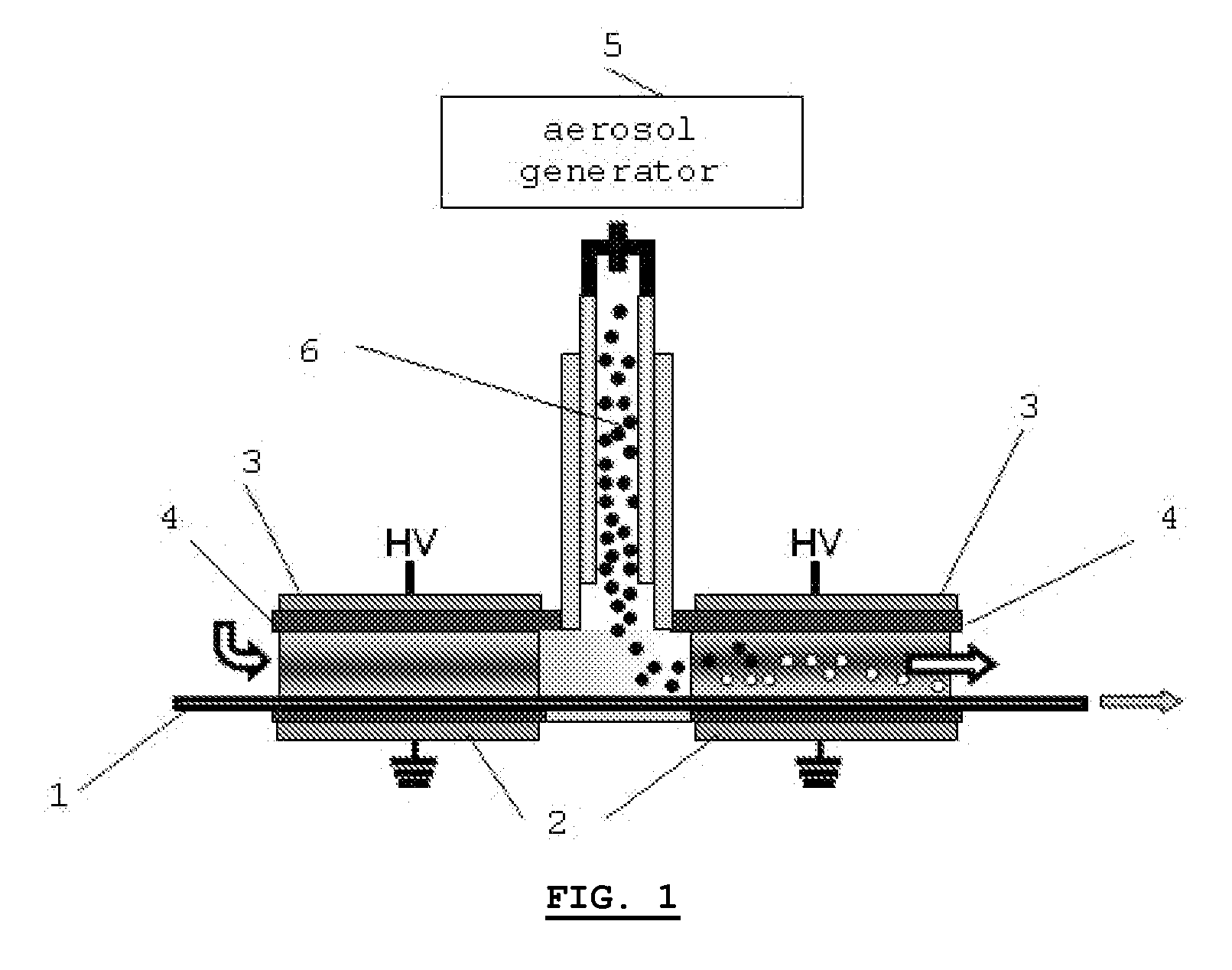Method for producing a coating by atmospheric pressure plasma technology
a plasma technology and atmospheric pressure technology, applied in the field of atmospheric pressure plasma technology, can solve the problems of low-pressure plasma, large investment in industrialization process, and high cost of high-efficiency reactors, and achieve the effects of increasing the reactivity of the substrate, improving the reactivity of the mixture, and improving the control of the precursor injection
- Summary
- Abstract
- Description
- Claims
- Application Information
AI Technical Summary
Benefits of technology
Problems solved by technology
Method used
Image
Examples
example 1
[0034]The plasma treatment is carried out in a specially designed parallel plates installation at 1.5 kHz. A sheet of poly(ethylene terephtalate) of 20×30 cm2 is placed on the lower electrode of the installation. The activation step is carried out under nitrogen at a flow of 40 slm, for 30 seconds at a power of 0.8 W / cm2. The power is lowered to 0.15 W / cm2 and ethyl hexyl acrylate is then injected under the form of an aerosol in the plasma zone under a nitrogen flow of 20 slm. The coating deposition is carried out during 2 minutes. The coated substrate is then subjected to UVA (>320 nm) radiation at a power of 120 mJ / cm2, during a time of about 60 s.
example 2
[0035]As described in example 1, the substrate is first submitted to an activation step under nitrogen at a flow of 40 slm, for a 30 seconds at a power of 0.8 W / cm2. The power is lowered to 0.15 W / cm2 and a mixture of ethyl hexyl acrylate (90 w. %) and pentaerythritol penta / hexa acrylate (10 w. %) is then injected under the form of an aerosol in the plasma zone under a nitrogen flow of 20 slm. The coating deposition is carried out during 2 minutes. The coated substrate is then subjected to UVA radiation at a power of 120 mJ / cm2.
example 3
[0036]As described in example 1, the substrate is first submitted to an activation step under nitrogen at a flow of 40 slm, for a 30 seconds at a power of 0.8 W / cm2. The power is lowered to 0.15 W / cm2 and a mixture of ethyl hexyl acrylate (90 w. %), pentaerythritol penta / hexa acrylate (8 w. %), 4-(dimethylamino)benzophenone (1 w. %) and 4-(hydroxyl)benzophenone is then injected under the form of an aerosol in the plasma zone under a nitrogen flow of 20 slm. The coating deposition is carried out during 2 minutes. The coated substrate is then subjected to UVA radiation at a power of 120 mJ / cm2.
PUM
| Property | Measurement | Unit |
|---|---|---|
| Wavelength | aaaaa | aaaaa |
| Wavelength | aaaaa | aaaaa |
| Surface energy | aaaaa | aaaaa |
Abstract
Description
Claims
Application Information
 Login to View More
Login to View More - R&D
- Intellectual Property
- Life Sciences
- Materials
- Tech Scout
- Unparalleled Data Quality
- Higher Quality Content
- 60% Fewer Hallucinations
Browse by: Latest US Patents, China's latest patents, Technical Efficacy Thesaurus, Application Domain, Technology Topic, Popular Technical Reports.
© 2025 PatSnap. All rights reserved.Legal|Privacy policy|Modern Slavery Act Transparency Statement|Sitemap|About US| Contact US: help@patsnap.com


